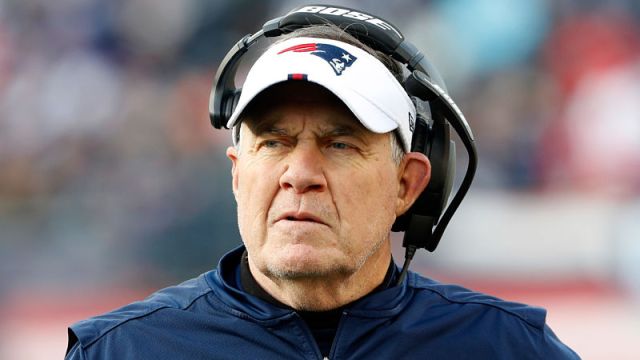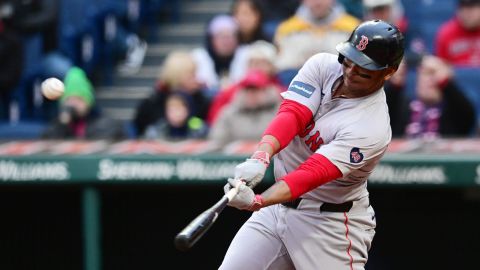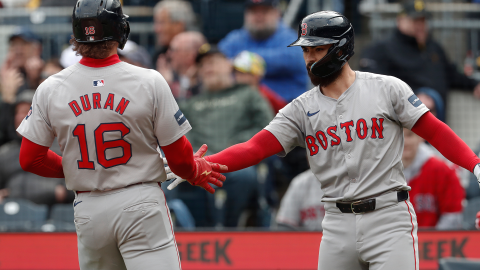Evaluating the Mookie Betts/David Price trade from the Boston Red Sox’s perspective is the ultimate test of seeing the forest for the trees.
There’s simply no way one can look at the reported three-team deal, in which Boston received outfielder Alex Verdugo from the Los Angeles Dodgers and pitcher Brusdar Graterol from the Minnesota Twins, and rationally conclude the Red Sox are positioned to improve in 2020.
Betts, a four-time All-Star and the 2018 American League MVP, is a generational talent who sits a tick below Mike Trout among Major League Baseball’s superstars. And Price, for all of his warts (unreliable health, inconsistent production, cumbersome contract, polarizing personality, etc.), at least offered upside in the middle of Boston’s rotation, arguably the team’s biggest weakness.
Still, that doesn’t mean the Red Sox’s decision to trade Betts and Price was ludicrous, by any means. Sometimes, you need to swallow hard and make an unpopular choice, knowing the immediate backlash, while harsh, eventually will subside, as the long-term vision comes into focus.
Sure, it’s jarring to see the Red Sox — a team consistently among Major League Baseball’s biggest spenders — reportedly trade two high-profile players, including one of the best in franchise history, with an eye toward cost efficiency. Doubly so when the deal bolsters the Dodgers, another organization with deep pockets, and comes during the same offseason in which the New York Yankees shelled out a nine-year, $324 million contract to land MLB’s premier free agent in Gerrit Cole.
But if you take emotion out of the equation, much like Betts has vowed to do with his free agency next offseason, you’ll see there are several reasons why Tuesday night’s reported blockbuster actually makes sense for Boston.
1. The Red Sox probably weren’t going to re-sign Betts.
It’s important to make a distinction here. Could the Red Sox have kept Betts for 2020 and ultimately made him a contract offer he couldn’t refuse? Probably. Would it have been a wise decision? Debatable.
Whatever you think of Betts, the reality is baseball’s a sport where paying out the nose for a single piece rarely yields favorable results. So for as much risk as there is with trading away one of the game’s best players, there’s also significant danger in handing said player a contract in excess of $300 million or $400 million. (Betts reportedly asked for $420 million over 12 years.)
It’s hard to blame Boston — or any organization, for that matter — for settling on a number and drawing a line in the sand, even when engaging a player of Betts’ caliber, as he would need to buck an all-too-frequent trend to provide an adequate return on investment well into his 30s. While losing the face of the franchise stings, it doesn’t take much for a lucrative contract that looks logical in the moment to become a roster-defacing burden, at which point the narrative surrounding Betts would dramatically shift toward: Well, why did the Red Sox give him all of that money?
Instead, the Red Sox, likely sensing a huge gap in negotiations, decided to move on from Betts in order to acquire assets far more valuable than the draft-pack compensation they would’ve obtained had he played out his final season in Boston and left next winter via free agency after receiving a qualifying offer. Totally reasonable, from a risk-reward standpoint, unless you believe the Red Sox would have been legitimate World Series contenders in 2020 with Betts and now are relegated to pretender status without the star right fielder.
If you believe the Red Sox were a fringe team either way — the more likely scenario given their current shortcomings on the pitching side — then there’s really no point in them hindering their long-term outlook for the sake of winning, say, 87 or 88 games in 2020 as opposed to, say, 82 or 83. Yet that’s exactly the direction Boston might’ve been headed had it kept Betts, blew past the luxury tax threshold for a third straight year and watched as he signed elsewhere next offseason.
2. Unloading Price (and half of his contract) is a win.
Price’s involvement in the Red Sox’s trade negotiations was one of the most fascinating aspects of this whole saga, in large part because it cast even greater uncertainty over Boston’s potential return. It always was apparent that attaching Price (owed $96 million over the next three years) to any deal would diminish the package Boston received, but to what extent all but certainly depended on just how much of the left-hander’s remaining money the Red Sox were willing to eat.
The Red Sox reportedly will absorb about half of Price’s deal — so $48 million (or $16 million annually) — as part of Tuesday’s trade. That’s far less palatable than dumping the entire contract, but it still creates substantial financial flexibility. Not to mention Price would have secured 10/5 rights after the 2020 season, giving him the power to veto any proposed trade. He truly would have “held all the cards,” which sounds like a nightmare waiting to happen.
Now, one could make the case the Red Sox should have shipped away Price in a separate deal, perhaps even an in-season swap after giving the veteran southpaw an opportunity to enhance his trade value while also allowing the MLB playoff picture to take shape. That approach obviously could have gone one of two ways, though, and the Red Sox clearly saw this as their best chance to offload a sizable chunk of Price’s contract onto a financially capable club while also securing enough talent in return.
Beyond the monetary incentive to trade Price, it’ll be somewhat refreshing for Boston to clear the slate. Although the Red Sox wouldn’t have won a World Series in 2018 without his strong postseason performance, Price was a recurrent headache whose demeanor might’ve worsened if Boston sputtered for a second consecutive season, especially if he failed to connect with whomever the organization hires to replace Alex Cora as their new manager.
3. The Red Sox now can be more aggressive next offseason (and beyond).
By trading Betts ($27 million salary for 2020) and Price (calculated at $31 million for luxury tax purposes based on the average annual value of his contract — minus the half the Dodgers reportedly will pick up), the Red Sox just shed approximately $43 million off their 2020 payroll, getting below the $208 million luxury tax threshold in the process.
This is significant, largely because it makes Boston better equipped to spend freely and retool next offseason, provided the club can live with the ebbs and flows it might encounter in 2020 by virtue of willingly weakening its roster via the departures of Betts and Price.
There’s a narrative floating around that the Red Sox’s desire to get below the $208 million mark stemmed from wanting to avoid a marginal tax bill — $10 million if they spent $228 million ($20 million above the threshold) — but the punishment is steeper than that. The Red Sox would have exposed themselves to greater draft/international penalties for signing free agents, lesser draft-pick compensation in exchange for departing free agents and reduced revenue-sharing rebates, all of which need to be considered from not just a business perspective but also in terms of building a sustainable on-field product.
Alex Speier of The Boston Globe wrote back in December: “If the Sox scale back their payroll to $205 million next season before returning to 2019 level of $243.5 million in 2021 and 2022, they could save a total of $90 million to $100 million over the next three years.”
The Red Sox chose to reset their penalty structure — they needed to at some point; just as the Dodgers and Yankees have done in recent years — and it could pay dividends in 2021, 2022 and beyond, even though it might suck to weather in the short term.
Hey, maybe they’ll even circle back and sign Betts next offseason — after he tests the open market — with the added benefits of avoiding steep penalties and reeling in two cost-controlled prospects with excellent potential?
OK, that’s a joke. Kinda. But the Red Sox will be positioned to make a splash ahead of the 2021 campaign or maybe even lock up Rafael Devers to a contract extension well before he’s slated to hit the open market, thus avoiding a similar snafu with another homegrown superstar down the road.
4. The Red Sox received legitimate talent in return.
Boston never was going to receive an elite prospect haul. Anyone suggesting the Red Sox should have netted Gavin Lux and Dustin May from the Dodgers or MacKenzie Gore and CJ Abrams from the San Diego Padres is living in Candy Land. Betts is phenomenal, obviously, and the Dodgers just solidified their case as World Series favorites by acquiring him. But Betts was looked at as a rental by most teams across the league given his obvious desire to test free agency, in turn hurting his stock.
The Red Sox, to their credit, created somewhat of a bidding war at the eleventh hour, which culminated with Boston landing Verdugo and Graterol, two players with impressive prospect pedigrees who’ve tasted the majors already and therefore figure to become immediate contributors in addition to coming with several years of team control.
Given the context the Red Sox did about as well as they could in a trade. They got a 3+ WAR OF w/5 years of team control & a pitching prospect w/significant upside. Instead of a third player, they cleared half of Price’s money, which puts them in a much better position long term.
— Ian Cundall (@IanCundall) February 5, 2020
Execs referred to below are RIVAL execs, not from #RedSox. Their overriding point: For many years, Sox made short-term decisions with little regard for future. They were left with a depleted farm system and an expensive roster. They eventually needed to pivot – or crash. https://t.co/5TvJXNAvuP
— Ken Rosenthal (@Ken_Rosenthal) February 5, 2020
Verdugo, who will turn 24 in May, is a good contact hitter with some pop. He’s also a strong defender who can play all three outfield spots. One shouldn’t expect Betts-level production, but Verdugo was the No. 19 prospect in baseball before the 2019 season, according to Baseball Prospectus, and did little to hurt that on-field reputation while posting a 3.1 WAR across 106 big league games.
Graterol, who will 22 in August, throws gas, topping out in the triple digits. He was MLB’s No. 33 prospect before 2019, according to Baseball Prospectus, and although the right-hander already has undergone Tommy John surgery, there’s enough to dream on for him to be a worthwhile trade target. Plus, if Graterol flops in the rotation, he could wind up being a shut-down late-inning reliever. (The Red Sox need both at this point.)
Is this enough to justify trading your best player? It depends who you ask. Given the other aforementioned variables, however, one certainly could do worse than the package chief baseball officer Chaim Bloom reportedly secured Tuesday night amid a sea of criticism directed toward the Red Sox.






